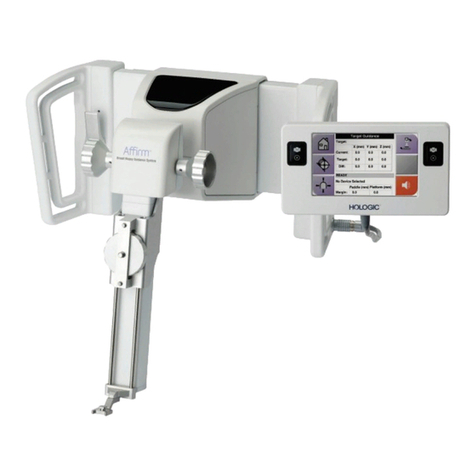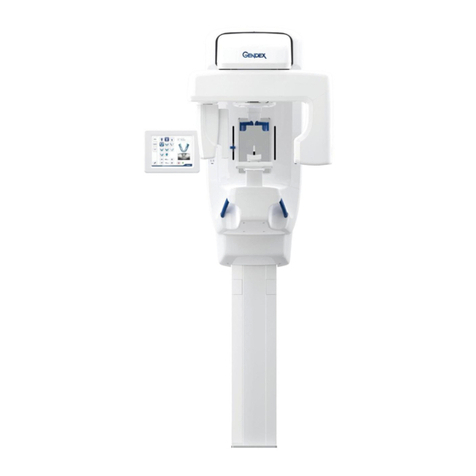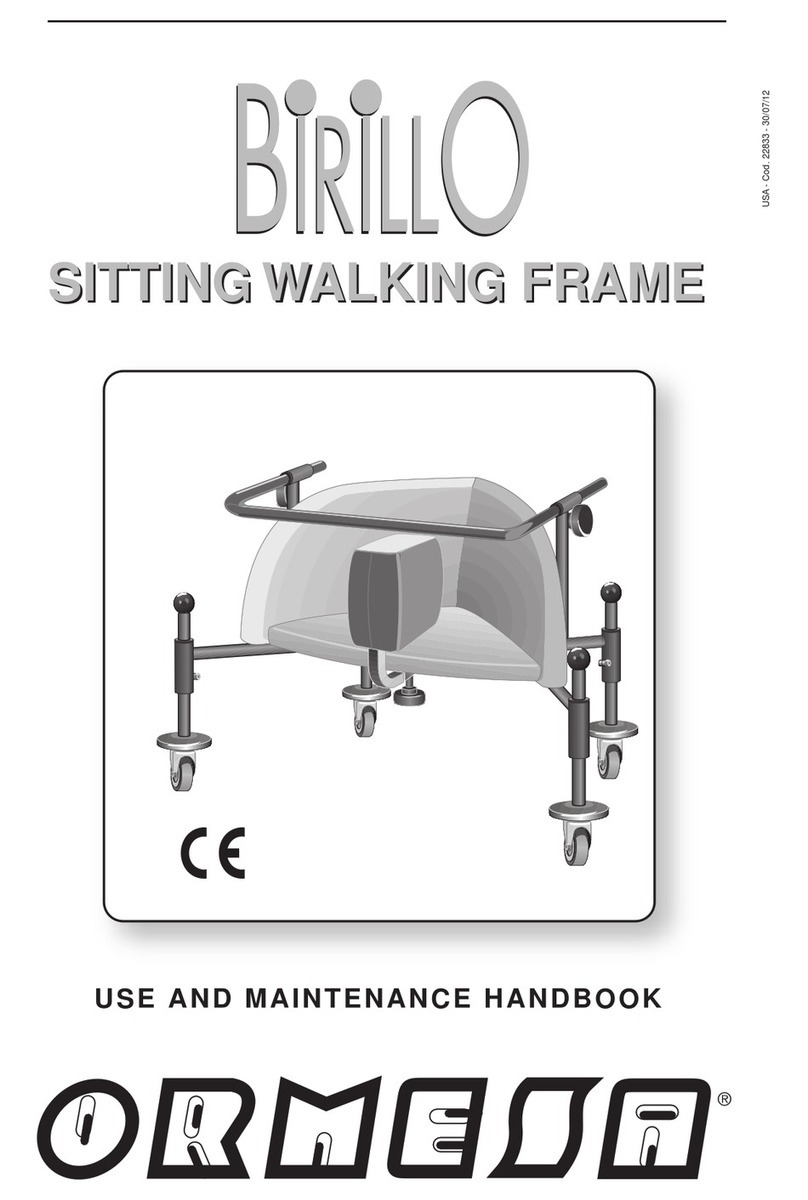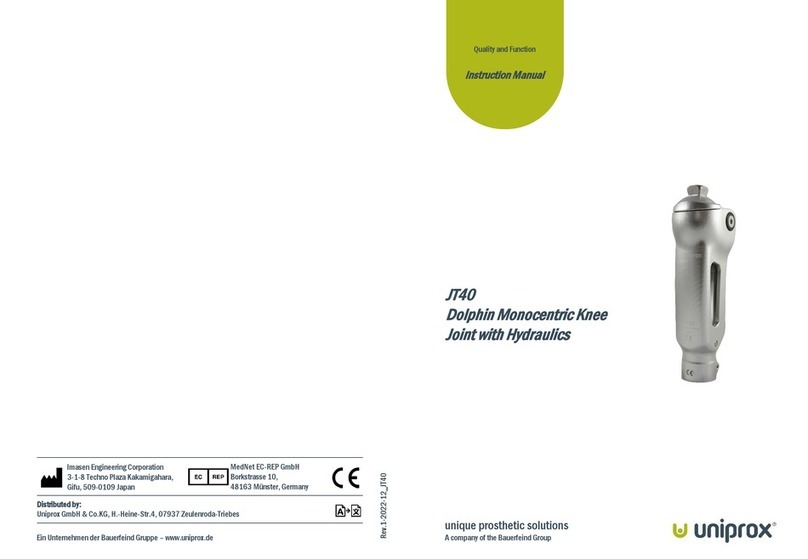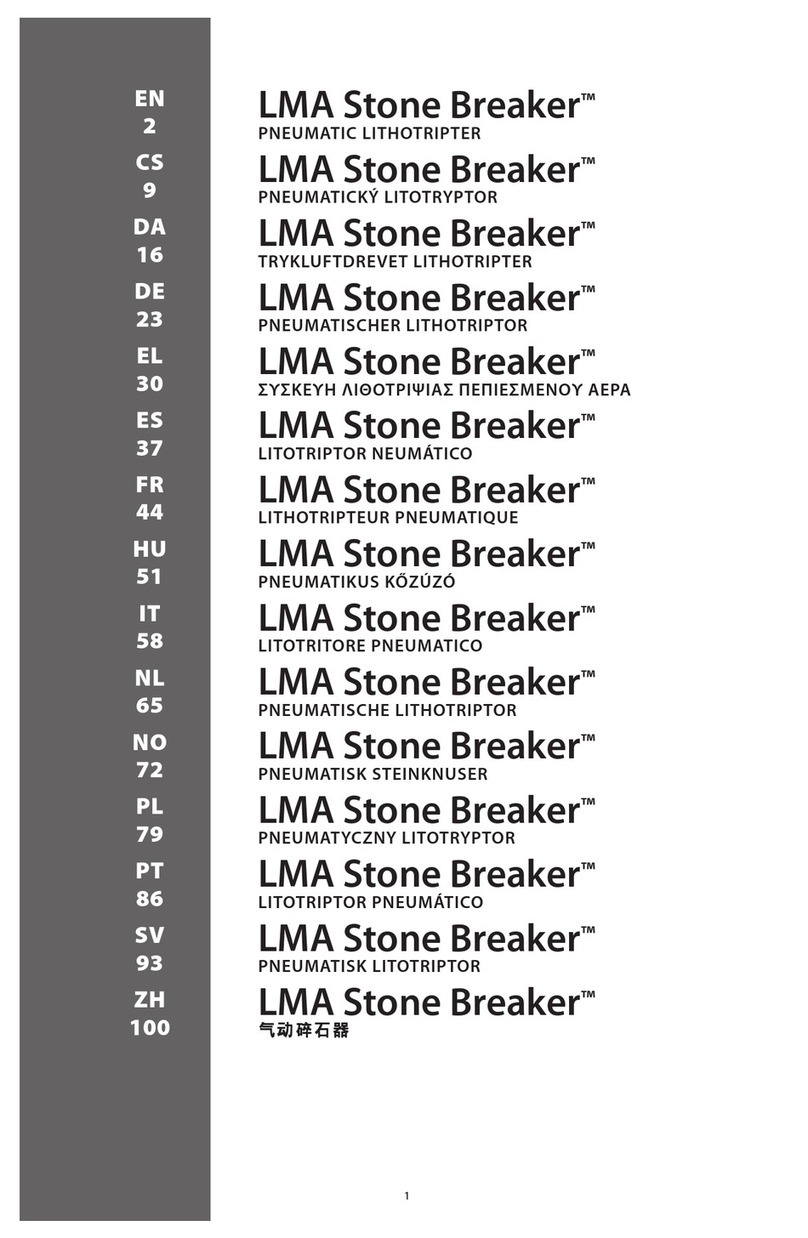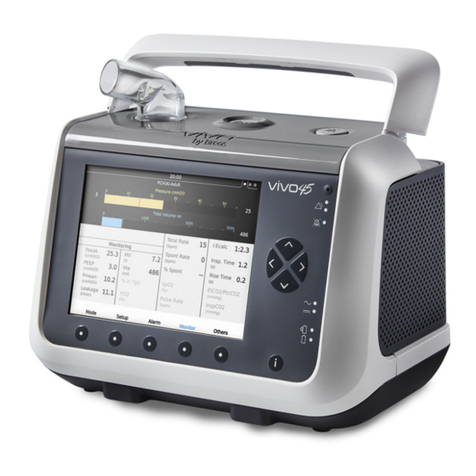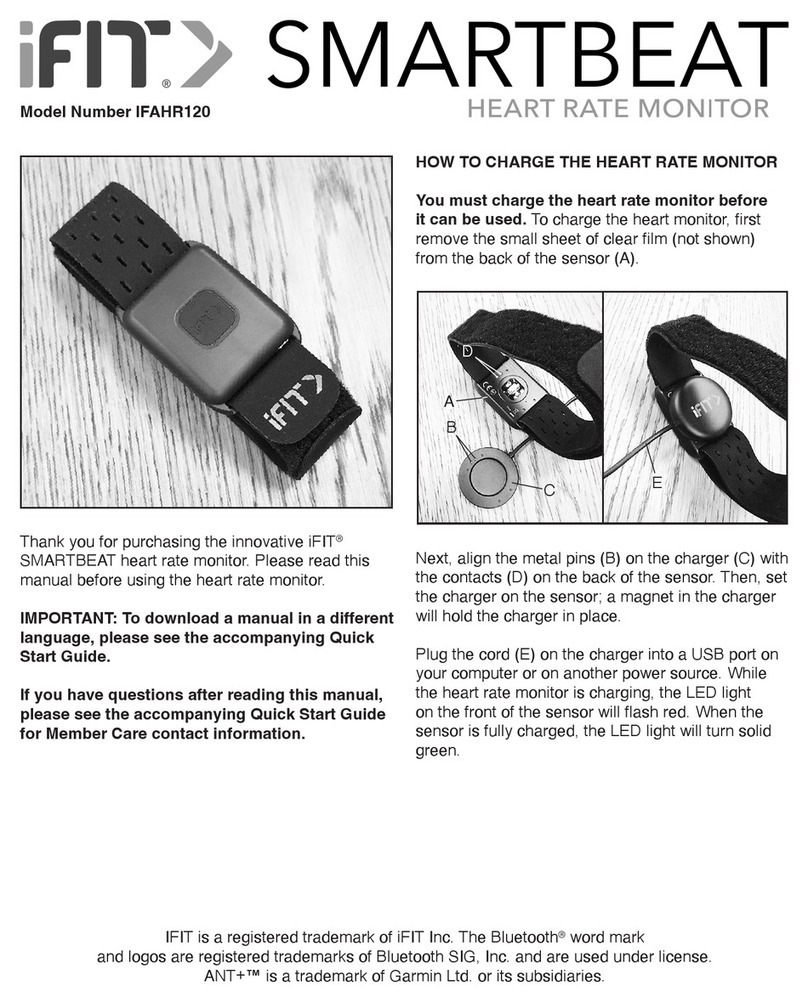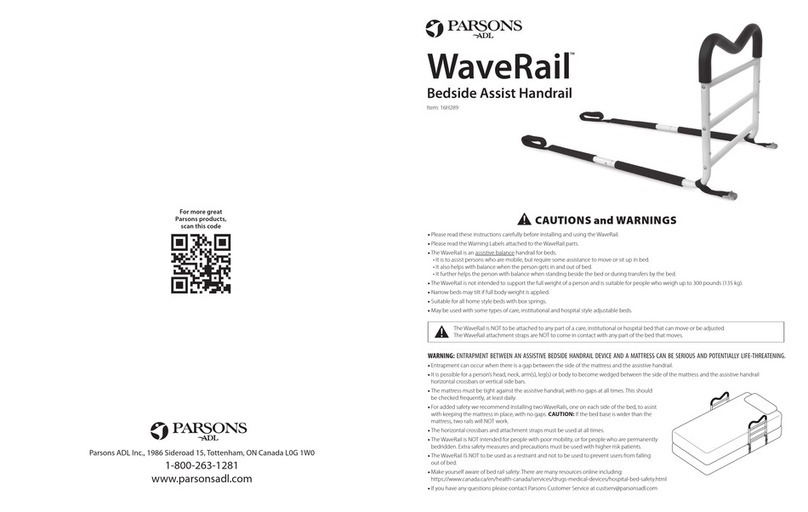Gradian Universal Anaesthesia Machine User manual

Universal Anaesthesia Machine®
Maintenance Manual
®

1
1-2
3-7
6-10
13-17
17
16-17
19-32
19
20
20-21
21
22
23
24
25-26
27
28
29-32
33
34-35
35-39
40
41
42
43
44
44-45
HOW TO GET HELP
GENERAL DESCRIPTION OF THE UNIVERSAL ANAESTHESIA MACHINE®
SPECIFICATIONS
COMPONENTS OF THE UAM®
UNPACKING AND PREPARING FOR USE
RECOMMENDED UAM MAINTENANCE SCHEDULE
FULL FUNCTION TEST
MAINTENANCE PROCEDURES
Cleaning or Replacing the Primary Air Filter
Replacing the Consumable Oxygen Sensor
Removing and Replacing the Draw-Over Vaporizer
Cleaning the Halothane Vaporizer
Replacing the Fenton Balloon
Replacing the Analyzer Screen Circuit Board
Replacing the Concentrator Loss of Power Alarm Battery
Removing the Concentrator
Installing the Concentrator
Replacing the Analyzer Screen Battery
Removing, Inspecting and Cleaning the Pressure Relief Valve
PROBLEM SOLVING
MAIN PARTS
ILLUSTRATED PARTS
APPENDIX I: BREATHING CIRCUIT DIAGRAM
APPENDIX II: OXYGEN CONCENTRATOR FLOW DIAGRAM
APPENDIX III: ELECTRICAL DIAGRAM
APPENDIX IV: UAM SERVICE RECORD
APPENDIX V: UAM INSPECTION LABEL
APPENDIX VI: PRESSURE CONVERSIONS & COLOUR IDENTIFICATION FOR MEDICAL GASES
Copyright © 2020 by Gradian Health Systems. All rights reserved.
Gradian Health Systems, UAM,and the Gradian logo are registered trademarks (®) of Gradian Health Systems, registered
in the United States.
Printed in the United States of America.

HOW TO GET HELP
EMAIL:
WEB:
service@gradianhealth.org
www.gradianhealth.org
WHATSAPP: +254 794 764 415
ADDRESS: Gradian Health Systems, 40 W 25th St., 6th Floor, New York, NY 10010, USA
NOTE: For the latest UAM specifications and technical materials please visit us online at:
http://www.gradianhealth.org/our-products/uam/
GENERAL DESCRIPTION OF THE UNIVERSAL ANAESTHESIA MACHINE®
The UAM® combines elements from both continuous ow and draw-over designs to provide a workstation that delivers
controlled anaesthesia in all hospital settings.
The breathing system is a low pressure (limited to 5 cm H2O) continuous ow system that defaults to a demand-ow (draw-
over) system when the supply fails. There are three one-way valves and a balloon operated inating valve which provide this
uniquely versatile method of anaesthesia delivery.
Oxygen can be provided from a variety of sources, and if none of those sources is available the machine will automatically
draw in room air without the need for the user to change settings. The vaporizer provides calibrated delivery of anesthetic
agent and the manual bellows ensures that safe assisted respiration can continue without requiring a high pressure gas
source.
The system has been designed to accept standard anaesthesia accessories such as the breathing circuit, oxygen sensor,
and standard connectors for the oxygen and nitrous oxide supplies. The UAM is also designed for simple eld service. Most
components can be removed with standard tools and local technicians can install replacement parts without removing the
UAM from the hospital.
The UAM carries the CE Mark, having passed EU regulatory inspections. It is manufactured in an ISO-certied factory in
England. It is used in a wide variety of hospitals, from internationally recognized academic centers to resource-constrained
district hospitals.
The Universal Anaesthesia Machine ensures that an adequate supply of oxygen and anaesthesia is always available to meet
patient demand, no matter what the environment.
The UAM provides several ways to deliver oxygen, including connections for cylinder and pipeline. Most importantly, the
machine produces its own oxygen using an integrated concentrator that converts room air into 95% oxygen. Air is drawn
into the UAM and is puried by 2 different lters. Ambient air is made up of 78% nitrogen, 21% oxygen and 1% other gases.
The electrically powered oxygen concentrator in the UAM removes nitrogen from room air, creating a mixture that is 95%
oxygen and 5% other gases.
The compressed air passes into a canister lled with a powdered material called Zeolite. Nitrogen sticks to the Zeolite,
while oxygen and other gases ow through it to a reservoir tank. The UAM produces up to 10 liters per minute of up to 95%
oxygen. The oxygen then travels through the rotameter bank into the back bar and reservoir bag.
GAS FLOW IN THE PATIENT SYSTEM
The ow dials control the amount of oxygen entering the back bar and available for the patient. The spinning bobbin in each
rotameter shows the ow rate in liters per minute.
The back bar provides the following functions:
1. The reservoir bag stores up to 2 liters of oxygen.
2. The pressure relief valve limits pressure in the back bar to 5 centimeters of water, protecting the patient from harm.
3. The air inlet valve allows room air to be drawn in whenever the supply of oxygen is less than the demand, as expressed
by the patient’s minute volume.
1

The low-resistance draw-over vaporizer adds volatile agent to the carrier gas passing through it. Volatile agent is added by
using the selector wheel to achieve the desired percentage. The resulting anesthetic supply gas is comprised of oxygen,
volatile agent and a variable amount of room air. The anesthetic supply gas ows from the back bar at low pressure to the
breathing block and the bellows.
An oxygen analyzer measures the oxygen concentration of the supply gas passing to the patient. The reading is displayed
on the analyzer screen.
As the supply gas ows past the sampling point for the consumable oxygen sensor, it passes the rst one-way valve, then
enters the bellows chamber. Depending on the conguration, the second one-way valve is immediately after the bellows in
the breathing block, or on the inspiratory Y-piece connection.
During spontaneous breathing both non-return valves open for inspiration and close during expiration. The bellows will not
ll with exhaled gas.
The bellows is used for intermittent positive pressure ventilation, also known as IPPV or controlled ventilation. When the
bellows is raised, supply gas ows through the rst non-return valve into the bellows. The second non-return valve remains
closed.
As the bellows are pushed down, the supply gas ows out through the second non-return valve into the inspiratory limb. The
rst non-return valve is closed.
Another pressure relief valve ensures that excessive manual force on the bellows cannot cause harm to the patient.
The UAM uses a conventional Y-piece patient connection. Exhaled gas returns to the UAM via the expiratory limb of the
Y-piece and then passes by a third one-way valve and the Fenton balloon to the scavenger port. The balloon acts as an
inating valve which enables controlled ventilation of the lungs, the third valve prevents back-ow during spontaneous
breathing.
2

UAM CONFIGURATIONS
IF YOUR UAM DOES NOT LOOK LIKE PICTURES PRESENTED ELSEWHERE, DO NOT BE ALARMED. The UAM has two
different designs depending on when it was manufactured: Rev A (for UAMs manufactured before October 2018) and Rev
B for UAMs manufactured after that date. UAMs with a serial number prior to 21501-001 are Rev A. Serials numbers after
this are Rev B. The order and exact location of select components depends on the design. Your institution may or may
not have also purchased a UAMV and/or a patient vital sign monitor, which sit on top of the UAM.
Photos and Diagrams specific to one configuration will be highlighted with a grey border (Rev A: manufactured before
October 2018) or orange border (Rev B: manufactured after October 2018) Photos and diagrams that lack borders apply
to both UAM designs.
3
Rev A
Before Oct. 2018
Rev B
After Oct. 2018

SPECIFICATIONS
PHYSICAL AND ELECTRICAL
g Workstation: 146cm x 53cm x 69cm, 130kg; aluminum frame, vertical mounting side rails on both sides, nylon internal tubing
g Top shelf: 54 cm (W) x 37 cm (D), maximum load 35 kg with even load distribution; Epoxy powder coated pressed aluminum;
monitor brackets bolt items to the top of the top shelf
gDrawer: 10cm x 29cm x 32cm in A, 11cm x 29cm x 24cm in B; 35kg weight limit, stainless steel, removable for cleaning.
gWork surface: Stainless Steel, 46 cm (W) x 31 cm (D) x 88 cm (H) above ground (removable) in A, 46 cm (W) x 26 cm
(D) x 88 cm (H) in B
gMains power supply: 220V, 50-60Hz
gPower: 500 Watts/220v = 2.27 amps
gOxygen analyzer power: CE-marked, fused and medical grade. Mains powered with battery backup for ten hours of use.
g Automatic over/under voltage mains power isolator protects oxygen concentrator, and sockets for monitor and accessories
g3.5” TFT touch screen for oxygen percentage display and alarm setting
gMembrane switch for oxygen analyzer power
gCasters: 150 mm diameter single wheel antistatic casters, front lockable casters
OXYGEN SUPPLY AND MONITORING
gOxygen concentrator ow rate: 0.1 to 10.0 liters per minute
g Maximum oxygen concentration: 95%
NOTE: The oxygen concentration may vary according to ambient humidity and maintenance of the air lter
gAlternative sources: cylinder yoke, pipeline, or other external ow regulated portable oxygen source
gAutomatic room air intake when patient minute volume exceeds supply gas ow
gAccuracy of glass rotameter for O2: +/- 2.5% when using 100% O2
gIntegrated inspiratory oxygen analysis uses a MOX-3 oxygen sensor
gCalibration for room air (21%) and 100% oxygen
gPressure sensitive apnea or high ow alarm
gAdjustable minimum and maximum oxygen alarm settings
gUp to ten hour analyzer battery backup, trickle recharge from mains power
gMembrane keypad and touch screen
OPTIONAL USE OF NITROUS OXIDE
gSources: pipeline or cylinder
gHypoxic cut-off: A solenoid automatically shuts off nitrous oxide delivery if supply gas O2level falls below a minimum of 25%
gFlow of N2O stops if electrical power fails
gSight and touch differentiated ow control dial per ISO standards
gAccuracy of glass rotameter for N2O: +/- 2.5%
VENTILATION
gManual bellows for adult and pediatric use made from durable, long-lasting silicone rubber
g 1600cc capacity
g Inspiratory pressure relief of 55 cmH2O for pressure created during mechanical ventilation
g Aluminum bellows block
g Silicone balloon inating valve at the expiratory port
g 15mm female/22mm male ISO standard taper connection for breathing circuit, 30mm male ISO standard taper connection for AGSS
scavenging equipment
VAPORIZERS
g Stainless steel and plated brass construction
g Draw over ow type
g Pour ller type.
g Separate units for isourane, sevourane, and halothane per ISO standards
g Agent delivery range: 0.5% to 4%
g 120ml capacity
4

3LPM 4LPM 5LPM 6LPM 7LPM 8LPM
4.5
4
3.5
3
2.5
1
1.5
1
.5
0
TYPICAL HALOTHANE VAPORIZER PERFORMANCE WITH FLOW
4%
3%
2%
1.5%
1%
.5%
g Performance:
150C 220C 250C 300C 350C
6
5
4
3
2
1
0
4%
3%
2%
1%
TYPICAL HALOTHANE VAPORIZER PERFORMANCE WITH TEMPERATURE
5

150C 220C 250C 300C 350C
6
5
4
3
2
1
0
4%
3%
2%
1%
TYPICAL ISOFLURANE VAPORIZER PERFORMANCE WITH TEMPERATURE
3LPM 4LPM 5LPM 6LPM 7LPM 8LPM
4.5
4
3.5
3
2.5
1
1.5
1
.5
0
TYPICAL ISOFLURANE VAPORIZER PERFORMANCE WITH FLOW
4%
3%
2%
1.5%
1%
.5%
6

REAR PANEL CONNECTORS
gMains isolator switch, 2 UK style power sockets
gOxygen and nitrous pipeline NIST connectors and cylinder yokes
gMulti-diameter external oxygen hose connector
7

COMPONENTS OF THE UAM
SEE INSET PAGE 9
8. Manual Bellows
9. Pressure relief valve
and gauge
10. Fenton Balloon
expiratory valve
11. Y-piece connectors
12. Water trap
13. Oxygen concentrator
status screen
14. Integrated oxygen
concentrator
15. Castors (front lockable)
1. Oxygen analyzer and
control screen
2. Oxygen and Nitrous Oxide
Flowmeter Bank
3. Back bar with air inlet,
pressure relief valve and
2 liter reservoir bag
4. Low resistance vaporizer
5. Oxygen concentrator
on/off switch
6. Oxygen cylinder and
pipeline pressure gauges
7. Nitrous Oxide cylinder
and pipeline gauges
8
NOTE A VS B

9
Pressure relief valve (inside)
Manual Bellows
Pressure gauge
1st and 2nd one-way valves
(inside Exterior Block)
Fenton Balloon
Inating Valve
Scavenging 30mm
taper connection
Y-piece connectors
One Way Valve (inside
Exhaust Block)
Fenton Balloon
Inating Valve
Scavenging 30mm
taper connection
Manual Bellows
Pressure relief valve
Y-piece connectors
Water trap
Pressure Gauge
A
B

10
Pin-indexed connectors for E-size
oxygen and nitrous oxide cylinders
Emergency oxygen inlet
Pipeline connections for
oxygen and nitrous oxide
Mains isolator (Power On/Off)
Fuses for oxygen analyzer,
oxygen concentrator
and outlet plugs
British-style 3 prong
electric outlets plugs
Consumable oxygen sensor
Ventilator taper
connection
B
B

11
5. Oxygen concentrator
on/off switch
6. Oxygen cylinder and pipeline
pressure gauges
7. Nitrous Oxide cylinder
and pipeline gauges
3. Backbar
a. Air inlet valve
b. Pressure relief valve
c. Reservoir bag
4. Low resistance vaporizer
1. Oxygen analyzer
and control screen
2. Flowmeter Bank:
Oxygen and Nitrous
Oxide Rotameters
Percent Oxygen (shows the
oxygen percentage of the
anesthetic gas measured
before inspiration)
Battery charge status
Message Area
Apnea alarm on/off
Mains power indicator
(machine is on mains power supply)
Calibration settings (to
calibrate oxygen sensor
and apnea alarm)
High oxygen percentage
alarm (user adjusted)
Mode (opens screen for
system settings)
Low oxygen percentage
alarm (user adjusted)
2. Flowmeter Bank:
Flow dials
INSET
ANALYZER SCREEN

12

13
PREPARING THE UAM FOR USE
1. Connect pipeline hoses and cylinders.
2. Open the top rear access panel if working on UAM B. Screw in oxygen sensor and connect telephone-style cable. Some
oxygen sensors come with an extra piece: this may be discarded. (See photo on next page.)
USING OXYGEN
The UAM accepts an E-size pin-index oxygen cylinder. The cylinder connects via a yoke and Bodok seal and the pressure is
displayed on the pressure gauge on the front of the machine.
Bull-nose cylinders may be attached to the pipeline inlet using an approved 4 Bar medical regulator.
USING A PIPELINE CONNECTOR
The UAM accepts pipeline connections for oxygen. Each machine is supplied with an oxygen hose connecting to the UAM’s
NIST inlet. The other end is typically shipped with a BS 5682 probe, which is the British standard. Probes for other connector
types can be arranged. Pipeline pressure is displayed on the gauge on the front of the machine.
USING THE EMERGENCY OXYGEN INLET
An emergency oxygen supply connection is mounted on the back of the machine. It accommodates differing tube sizes
from ward-style owmeters.
CAUTION: Oxygen from this source is not controlled by the rotameter bank on the front of the UAM. Rather, it must be
controlled with an external owmeter attached to the cylinder providing the emergency oxygen. The user can conrm that
oxygen is being given by observing the oxygen analyzer.
NOTE: Use only 1 L/minute ow to conserve the oxygen in the external cylinder. This will provide 30-35% oxygen to the
patient.
USING NITROUS OXIDE
The UAM supports cylinder and pipeline sources of nitrous oxide. The ow of N2O is controlled by the right hand side ow
dial. The N2O ow dial has a different size and shape to distinguish it from the oxygen ow dial.
The UAM automatically cuts off nitrous oxide if the percent of oxygen in the anesthetic mix falls to 25% and below. The
oxygen analyzer must be powered on and working correctly for nitrous oxide delivery to occur. An exhausted oxygen sensor
or battery will shut off N2O supply.
The cut off mechanism is electrical, unlike older style mechanical interlocks. The N2O valve is closed in its resting position
and must receive a current from the oxygen analyzer to open. Any interruption of that current, including a decrease in
oxygen below 25%, will shut off the ow of nitrous oxide.
NOTE: Do not open the package of the spare oxygen sensor until it is needed. The oxygen sensor will start to deplete as
soon as it comes into contact with air.

14
3. Attach bellows assembly to UAM by placing it on top of the connector and rmly pushing down. Then tighten knurled nut fully.
2.
Screw in oxygen sensor and connect telephone-style cable. Some oxygen sensors come with an extra piece: this may be discarded.
A
B
AB

15
4. Attach airway pressure gauge by pushing down collar and inserting gauge into the port. Press rmly until collar springs up.
5. Attach green reservoir bag to back bar as shown in photo.
AB

6. Attach patient circuit to inspiratory and expiratory ports.
7. Attach green plastic 30M-30F connector to the scavenging hose by inserting the male side into the hose. The female
side attaches to the one-way expiratory port underneath the Fenton balloon.
8. Connect 30mm hose to scavenging port, or attach standard scavenging device.
9. Operate the bellows, check that it lls freely with air from the air inlet and observe the Fenton balloon moves freely in it’s
housing when the bellows is moved. Occlude the Y-piece and check airway pressure reaches 45-55 cmH2O.
10. Connect and turn on mains power by pressing the green switch on the back of the UAM. Wait about 10 seconds for the
internal supply to come on, and then check the screen to see if the oxygen analyzer shows green. This indicates the
mains supply is working correctly.
NOTE: GRADIAN HEALTH SYSTEMS STRONGLY RECOMMENDS CONNECTING THE UAM TO A 2000-WATT
VOLTAGE STABILIZER.
16
AB

17
11. Calibrate oxygen analyzer using 100% O2 from cylinder or pipeline if available. NOTE: If cylinder or pipeline do not deliver
100% O2, only calibrate on room air as described below in 11c.
a. Using 100% cylinder/pipeline oxygen, set oxygen owmeter to 6 L/minute and wait for maximum reading on
monitor.
b. Press CAL, then O2, then GO. When the calibration is nished, press EXIT twice.
c. Turn off the oxygen. Draw room air through the system with the bellows until the reading reaches its lowest value.
d. Press CAL, then AIR, then GO. When the calibration is nished, press EXIT twice.
12. Calibrate apnea alarm pressure transducer as follows:
a. Make sure ow dials are set to zero ow and reservoir bag is empty
b. Press CAL, then PRESSURE: CAL, then GO. When the calibration is nished, press EXIT twice.
13. Turn on oxygen concentrator using the selector switch on the front of the machine. Set the oxygen output to 6 L/minute
and ensure that oxygen reaches at least 90 to 95% output after a few minutes.
14. If using nitrous oxide, check the function of the Nitrous Oxide cut off at 25% oxygen concentration as follows:
a. Set oxygen ow to 6 L/minute.
b. Set Nitrous Oxide ow to 4 L/minute.
c. Gradually reduce the oxygen ow to decrease the delivered O2 to 25% and lower—nitrous oxide ow should cut off.
15. Fill the vaporizer to maximum with correct anesthetic agent. See the directions in the User Manual. WARNING: Do
not overll the vaporizer. Do not spill agent on to the UAM, especially on to the oxygen sensor. UAM Conguration A
has the oxygen sensor in front. Cover the sensor with a protective cloth when lling the vaporizer on UAMs with this
conguration. Refer to the ll level window.
16. Place all manuals and training materials in drawer and secure a location for extras, such as the additional oxygen sensor,
spare balloons, and so forth.
NOTE: High levels of relative humidity in the environment will affect the performance of the UAM. It is recommended that
the UAM be used in areas where the humidity can be controlled. After operating the UAM in humid environments water
drainage should be observed underneath the machine once the concentrator is turned off and has depressurized.
IF YOU HAVE PURCHASED THE PATIENT VITAL SIGNS MONITOR:
1. Unpack monitor and insert the battery. The battery is in a white box inside the foam protectors holding the monitor
securely in the cardboard box.
2. Mounting the monitor: Please refer to the mounting instructions for the particular model of monitor obtained.
3. Connect patient cables to monitor – NIBP, SPO2, TEMP and ECG
4. Connect mains lead from monitor to one of the three prong sockets on the back of the UAM.
5. Allow patient monitor and analyzer screen batteries to charge for 24 hours.
RECOMMENDED UAM MAINTENANCE SCHEDULE
FREQUENCY ACTION
Daily or prior to use (user) Perform operational check (see UAM User Manual and Checklist on the UAM)
Every 3 months Perform full function test
Every 6 months Perform full function test
Check air filter- clean or replace if needed
Every 12 months Perform full function test
Check air filter- clean or replace if needed
Replace oxygen sensor
Replace oxygen concentrator loss of power battery (9V)
Remove and inspect Fenton balloon
Every 3 years Replace oxygen analyzer battery
Every 5 years Contact Gradian Health Systems for a complete maintenance check
[email protected] | +1.212.537.0340

FULL FUNCTION TEST (SEE CHECKLIST IN APPENDIX IV)
SYSTEM CHECKS
1. Check that no unauthorized modications have been made to the UAM. Check that the Ayre’s T-piece is present and
spares as originally supplied are present. Check oxygen tubing for venturi (Hudson type) mask is available.
2. UAM frame – check for any loose screws or panels and tighten as required. Check wheels.
3. Check mains cable and gas supply tube condition and repair as required.
4. Connect mains supply, turn on mains isolator switch (note that there will be a delay of around 10 seconds while the mains
lter starts) and check that the oxygen analyzer and patient monitor (if tted) yellow charging LED’s are visible.
5. Turn off the machine mains isolator and ensure that the Mains Power Indicator goes red – this indicates mains failure.
6. Check that the battery indicator icon shows three green segments and that it discharges with mains off and recharges
with mains on. NOTE: Battery must be replaced every three years or sooner if battery life is low.
7. Check that the cylinder yoke seals are tted and replace if damaged or missing.
8. Connect the cylinders to the yokes and ensure that the cylinder pressure is indicated on the correct pressure gauge
(nitrous oxide and oxygen) when turned on individually.
9. Connect the machine pipeline hoses to the supply outlets (wall outlet or bullnose cylinder regulator) and ensure that
pipeline pressure is indicated on the correct pressure gauge (nitrous oxide and oxygen) when connected and turned on
individually.
10. Turn on the oxygen and the nitrous oxide ow dials using each gas supply (concentrator, cylinder and pipeline) and ensure
that the maximum ow of 10 L/minute is achieved for each gas.
11. Close the ow dials and ensure that the ow stops.
12. Check that the emergency oxygen inlet functions by observing an increase of oxygen % on the analyzer.
OXYGEN CALIBRATION, SAFETY AND QUAVLITY CHECKS
13. Turn on the analyzer screen and ensure that the vaporizer is off. Turn on the oxygen cylinder or pipeline to provide 100%
oxygen, turn on a 6 liter/minute ow and wait for the oxygen sensor to stabilize, then press CAL – O2 – GO and wait for
the calibration to nish, then go back to the main display by pressing EXIT twice. If the oxygen sensor fails to calibrate or
an oxygen sensor exhausted alarm is present, replace the oxygen sensor.
NOTE: For the most accurate performance over the entire range of possible oxygen concentrations, the oxygen sensor must
be c
alibrated with both 100 % oxygen and 21% oxygen (room air). If 100% oxygen is not available then the it should at least be
calibrated with 21% oxygen. If the sensor has not been calibrated at 100% oxygen then the monitor will display 104% at higher
oxygen concentrations. Calibrating the cell at 100% oxygen can clear this condition.
NOTE: The oxygen sensor will need to be replaced approximately every 12 months. An alarm will indicate when the oxygen
sensor is exhausted.
14. With the oxygen turned off cycle the bellows to draw in air, wait for the oxygen sensor to stabilize, then press CAL – AIR
– GO and wait, then press EXIT to go to the main display. If the sensor fails to calibrate or an oxygen sensor exhausted
alarm is present replace the oxygen sensor.
15. Check that the high and low oxygen percentage alarms can be adjusted and that they function; this is achieved by turning
up the oxygen supply to exceed the high alarm or increasing the entrained air to fall below the lower alarm.
16. Increase the nitrous oxide ow and ensure that it cuts off when the oxygen concentration is 25% or lower.
17. Disconnect the oxygen sensor (mounted by the bellows in Conguration A, behind the rear top access panel in
Conguration B) – ensure that the disconnect alarm sounds and that nitrous oxide (if tted) turns off.
18. Set a 6 L/minute ow from the oxygen concentrator and ensure that the output stabilizes at 90% – 96% oxygen
concentration. increase the ow rate to 10 L/minute and ensure that the output remains at 90% or better. If the output
concentration is low check the lter condition and replace it if required.
BREATHING SYSTEM CHECKS
19. Turn on the oxygen ow with patient Y-Piece blocked and ensure that the reservoir bag lls and excess gas escapes
through the pressure relief valve and that maximum circuit pressure is around 5 cmH20. Conrm that the apnea alarm
sounds with a full bellows after 30 seconds and that it repeats every 30 seconds.
20. Turn off the owmeter and cycle the bellows and ensure that air is drawn in through the under pressure valve – this is
indicated by a slight uttering of the reservoir bag when it is empty.
21. Check condition of reservoir bag.
22. Check that the bellows assembly is securely connected to the machine and is undamaged, check for splits in the bellows
or displacement of the end plates, loosen and re-clamp centrally if required.
18
Table of contents
Popular Medical Equipment manuals by other brands
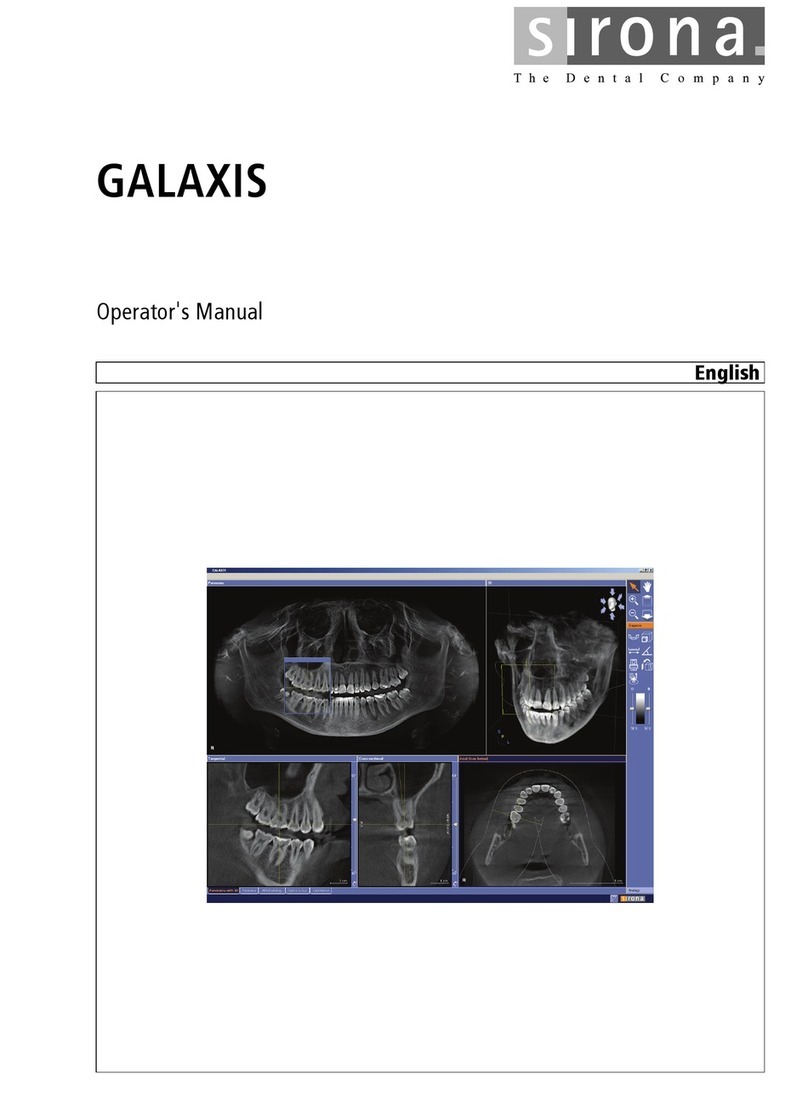
Sirona
Sirona Galaxis operating manual
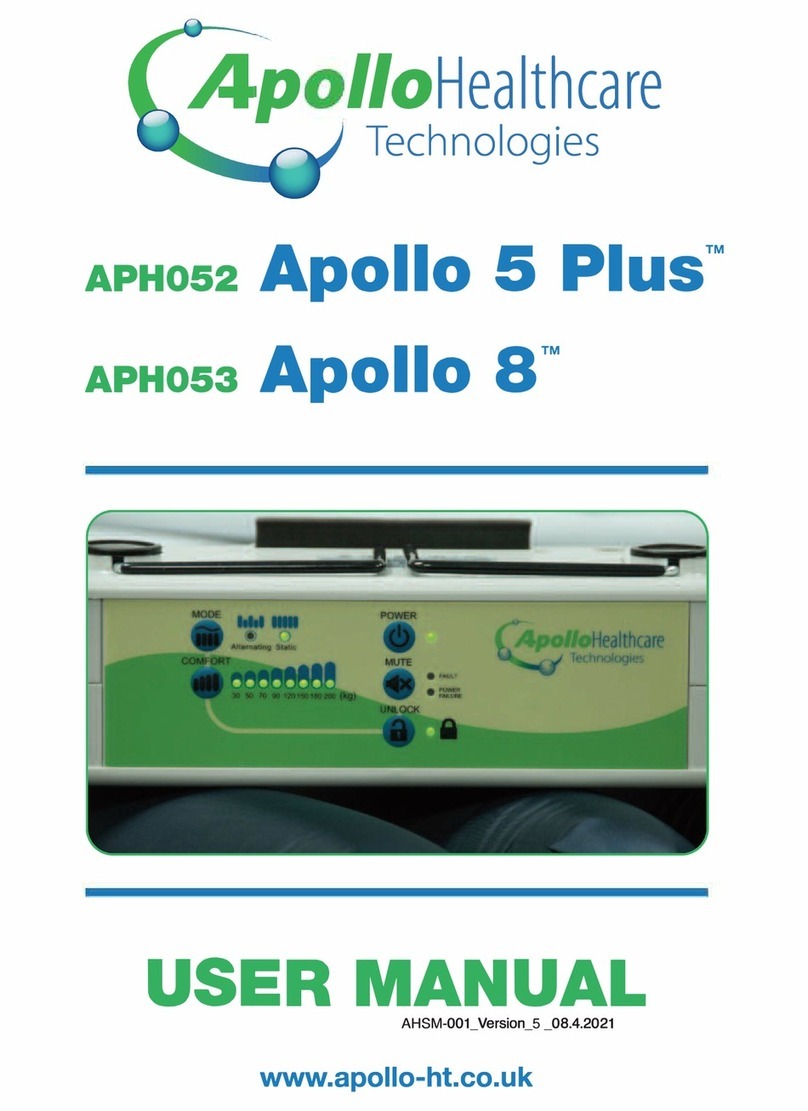
Apollo Healthcare Technologies Limited
Apollo Healthcare Technologies Limited Apollo 5 Plus APHos2 user manual
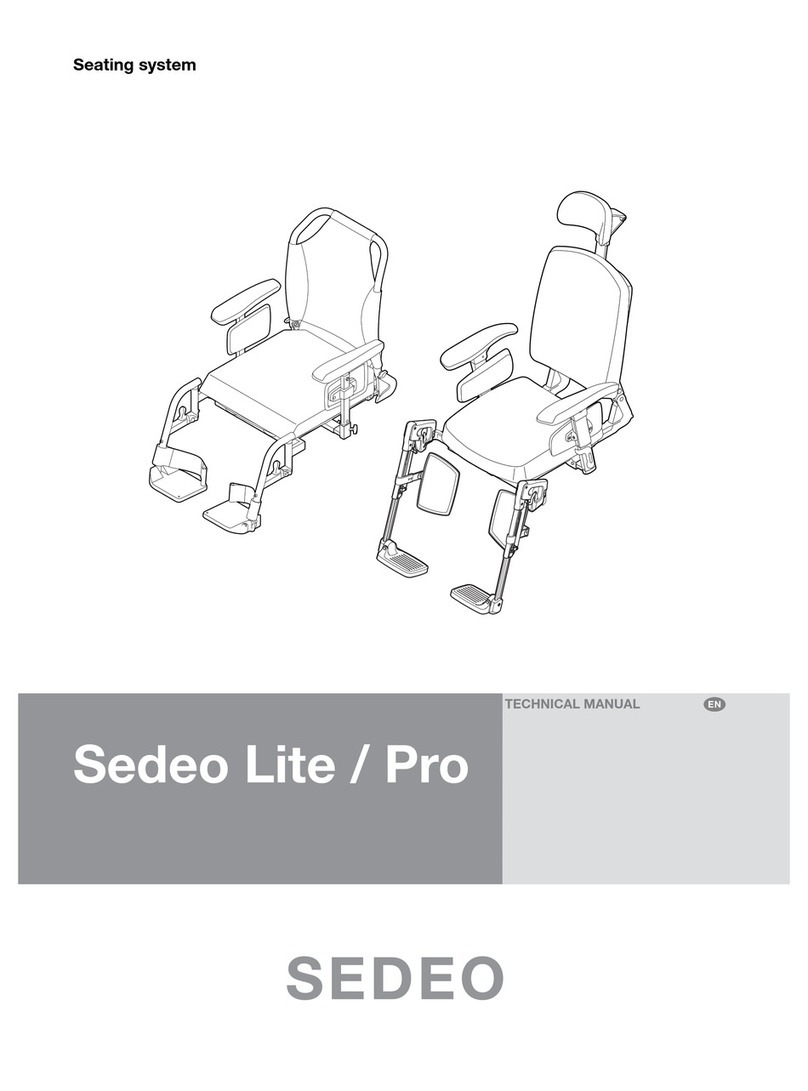
Sedeo
Sedeo Lite Technical manual

Huntleigh
Huntleigh Smartsigns MiniPulse Instructions for use
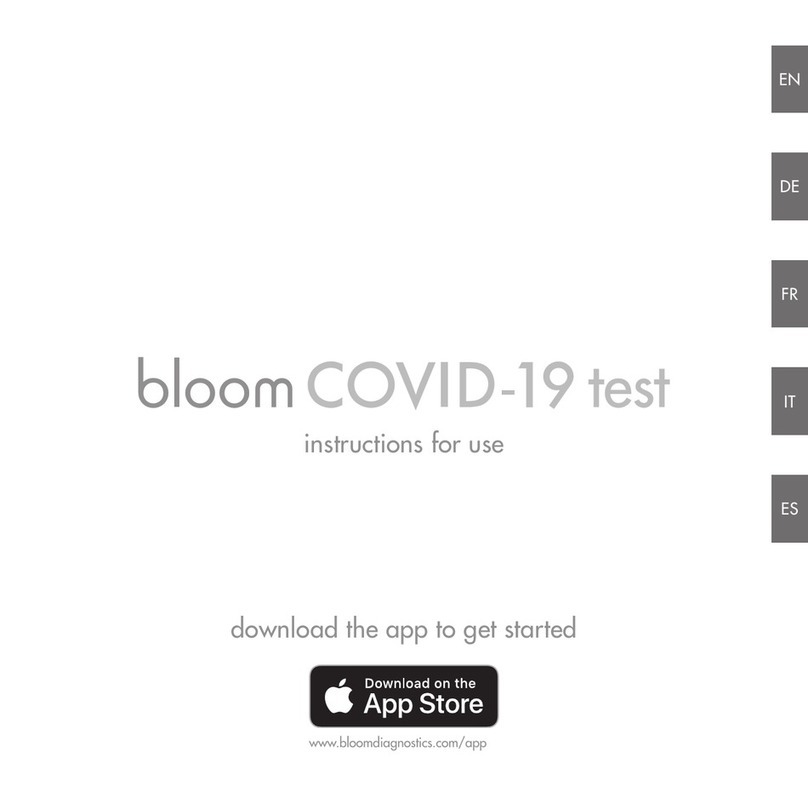
bloom
bloom COVID-19 test Instructions for use

Zeiss
Zeiss EXTARO 300 Instructions for use
